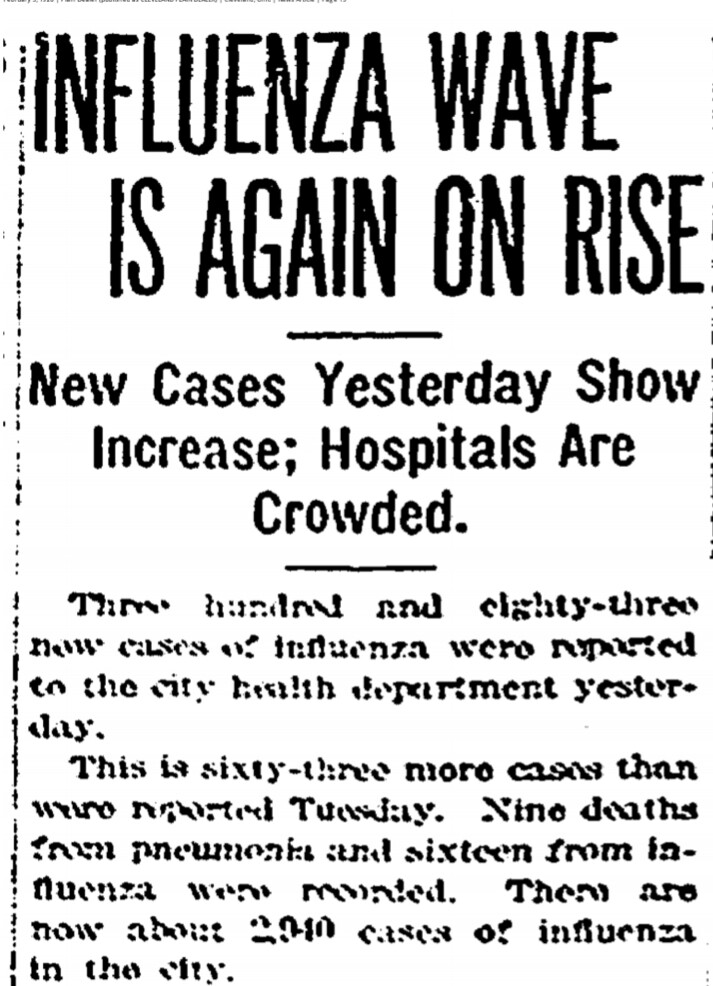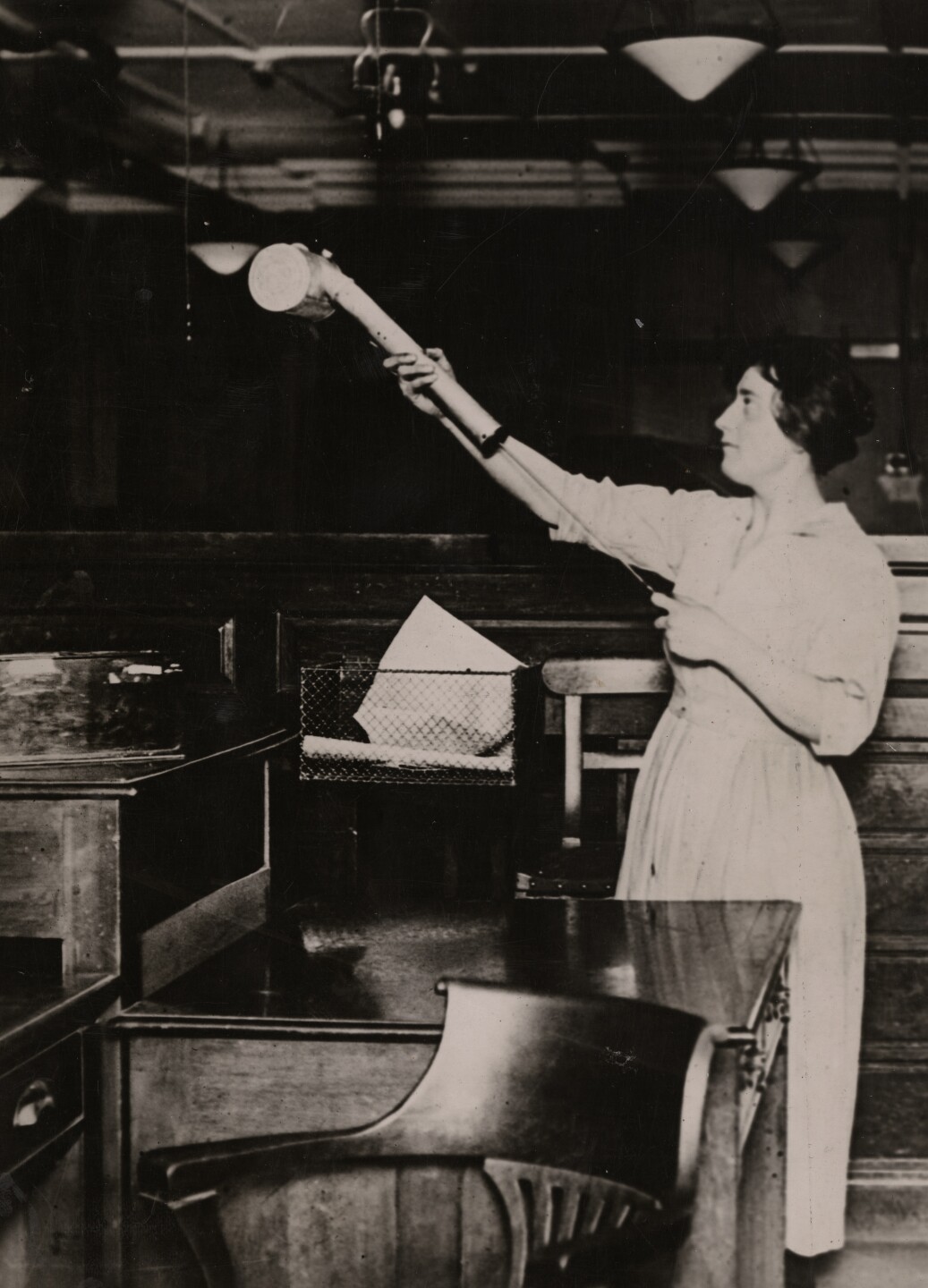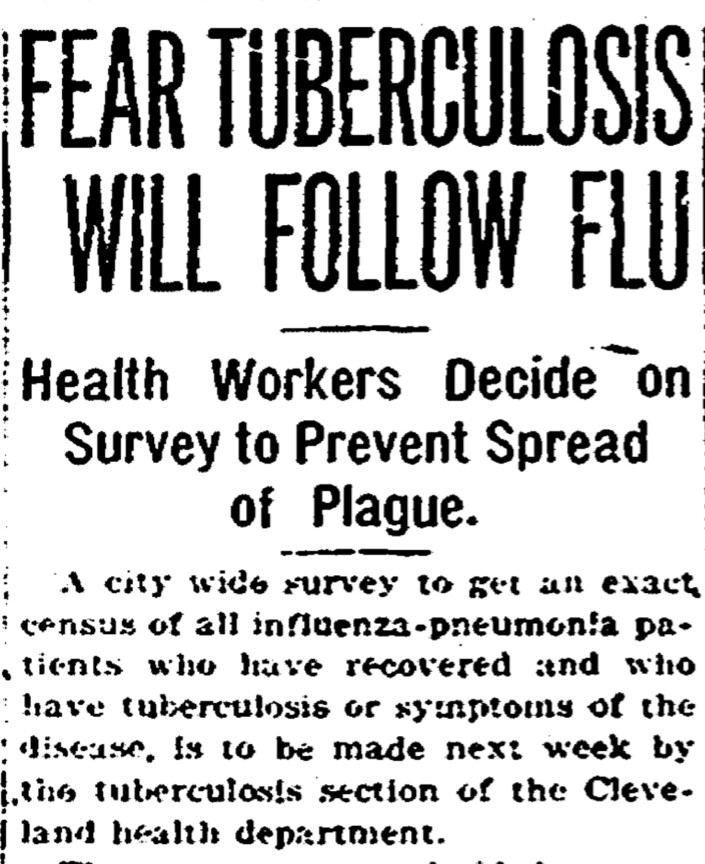CLEVELAND — The late 1910s brought a lot of pressure on a thriving Cleveland all at once. The way our community handled it a century ago can offer important lessons about how the same city a century later can emerge from the COVID-19 pandemic.
World War I was coming to a close when the Spanish Flu arrived in Northeast Ohio in 1918. Much of the population was falling ill in Cleveland, which was then the fifth largest city in the nation.
“The estimated death toll for the United States was 675,000, and for Cleveland more than 4,400 or 474 per 100,000 —a higher rate than that in Chicago or New York City,” writes the Case Western Reserve University Encyclopedia of Cleveland History.

“It was really just like now, a scary time,” said Cleveland Public Library Chief of Special Projects and Collections John Skrtic.
And yet, there was a war to win.
Old newspaper clippings show the city taking the disease seriously, with some mask wearing and shutdowns that cost hotels and restaurants the equivalent of about $20 million in today’s dollars.

But the war effort prevented a complete stoppage.
“There were no closures of factories in Cleveland during the 1918 epidemic,” said John Grabowski, Case Western Reserve University The Encyclopedia of Cleveland History Editor Professor. “They need the war production to keep them going.”
Recovering after the flu/war
The strong manufacturing base that contributed to the war effort was a big part of the reason Cleveland was a bustling city of roughly 900,000 people before the Spanish Flu. After that disease ran its course, the manufacturing industry drove the recovery.
“At least 1920-1929, that showed what Cleveland can come together and do and show the nation what was possible in building these amazing things that still last now,” said Skrtic.
Playhouse Square, Terminal Tower and the Cleveland Public Library were all built through the 1920s. The Indians won the World Series at League Park in 1920 and the Cleveland Clinic was founded in 1921.

“In our world today, I think there is a lot we can draw from the pandemic 100 years ago,” said Playhouse Square Foundation President and CEO Gina Vernaci. “The theaters were built in the wake of [the Spanish Flu and World War I.] Theaters opened after a World War, after financial collapse.”
That’s why even though Playhouse Square has been closed for a full year, canceling more than 1,000 performances, Vernaci is optimistic about the boom she’s expecting Cleveland to experience as more COVID-19 vaccines become increasingly available. When that happens, she says she’ll likely have tears in her eyes when audiences come through the doors again,.
“[Performances] stretch our imagination, they help us take in social issues that perhaps we don’t take in in other ways,” said Vernaci. “They help us realize that community is important.”

The region’s strong manufacturing industry before the war and flu helped Cleveland get back on its feet after those challenges had passed.
Despite some unrest immediately following World War I, Grabowski says workers got right back to building cars, manufacturing steel and building up downtown.
“That’s accompanied by something that starts before the war and really takes off after the war and that’s spacial expansion,” said Grabowski.
Clevelanders started to populate nearby suburbs in a move made possible by family cars and extended streetcar lines.

“We’re talking about real estate booming now,” said Grabowski. “It was really rolling in the 20s.”
More people moved to the region from Appalachia and the Deep South, growing Cleveland’s African-American population specifically, and the Greater Cleveland population in general. That population growth continued until the Great Depression.
It wasn’t until the 1970s that Cleveland saw severe population decline.
“We have been trying to reinvent out economic structure ever since,” said Grabowski.
Lessons for today
As the 2021 version of Cleveland slowly climbs out of the COVID-19 pandemic, it doesn’t have the manufacturing strength it had a century ago. The population is roughly half it’s all-time peak, and COVID-19 shutdowns came just as downtown was hitting its development and entertainment stride.
“We’re not building on a booming success behind us,” said Grabowski. “It’s an evolving one.”
He says the large number of downtown apartments and entertainment venues is a good sign. The broader hope is that new technology jobs can drive Cleveland into the future in the same way manufacturing once did.

In February, Cleveland-based MedPilot announced it is merging with New York-based medical technology company Vytalize showing that companies don’t have to be on the coasts to have a successful exit.
The merger was approved by both companies' Boards of Directors on Jan. 29 and is still subject to shareholder approval. The companies aren’t discussing the terms of the deal, but all 35 of MedPilot’s Cleveland workers will join Vytalize’s workforce, which now will be nearly 100 people strong.
Despite an October 2020 fire in his entertainment venue, Abdul Alja says he’s still betting on Cleveland to bounce back strong from the pandemic and the economic decline it caused.
“I’m really hoping the city does get built up because I see that there’s big potential here,” said Alja.
That’s why he still plans to reopen his venue when the weather gets warm to benefit from a vaccinated public looking to get outside.
Even if the circumstances are different a century later, Skrtic says Cleveland bounced back from a global pandemic once so that’s a good reason to think it can do it again.
“The more you know about the past, you can sort of ease your mind that there are better times on the horizon,” said Skrtic.
Download the News 5 Cleveland app now for more stories from us, plus alerts on major news, the latest weather forecast, traffic information and much more. Download now on your Apple device here, and your Android device here.
You can also catch News 5 Cleveland on Roku, Apple TV, Amazon Fire TV, YouTube TV, DIRECTV NOW, Hulu Live and more. We're also on Amazon Alexa devices. Learn more about our streaming options here.





